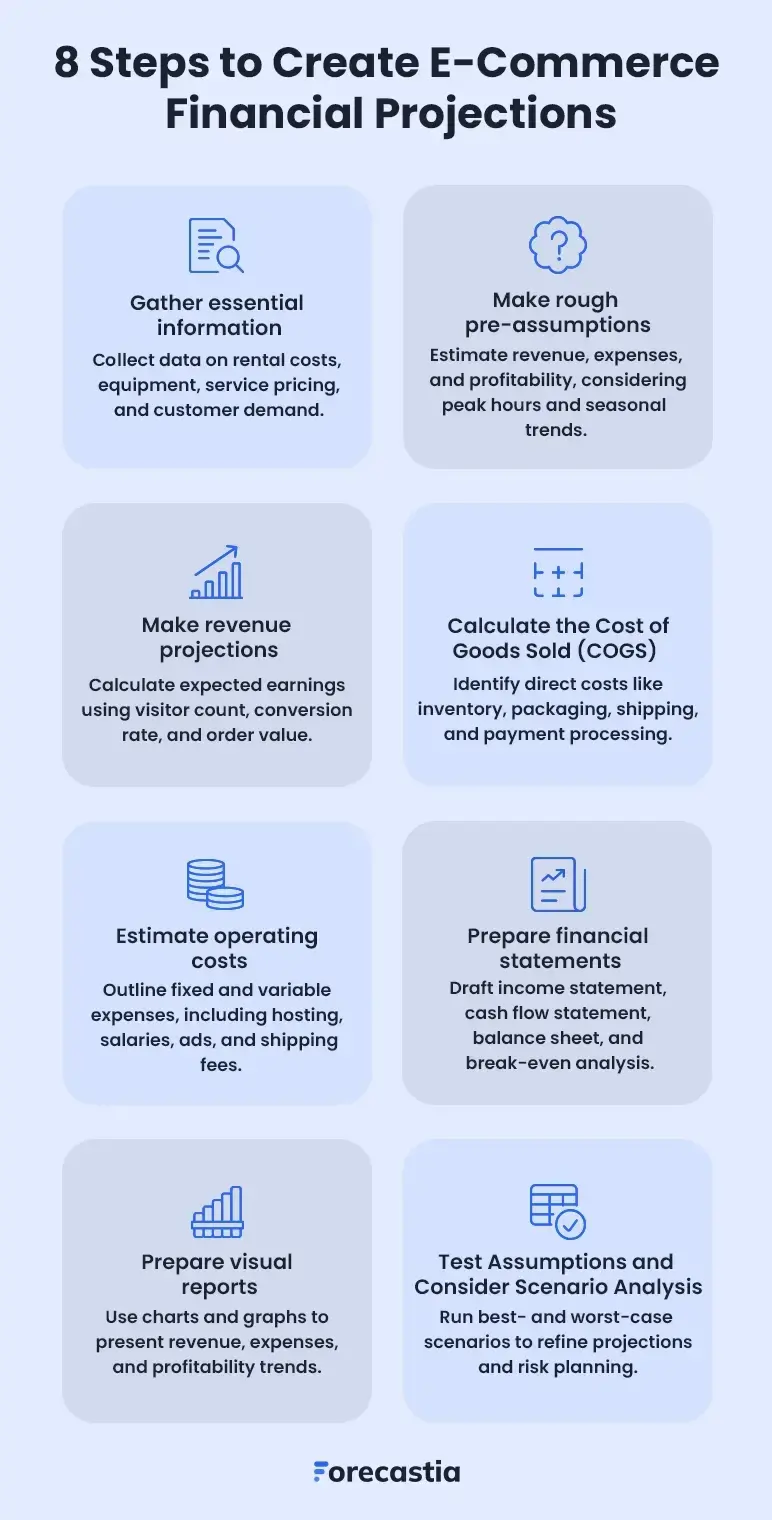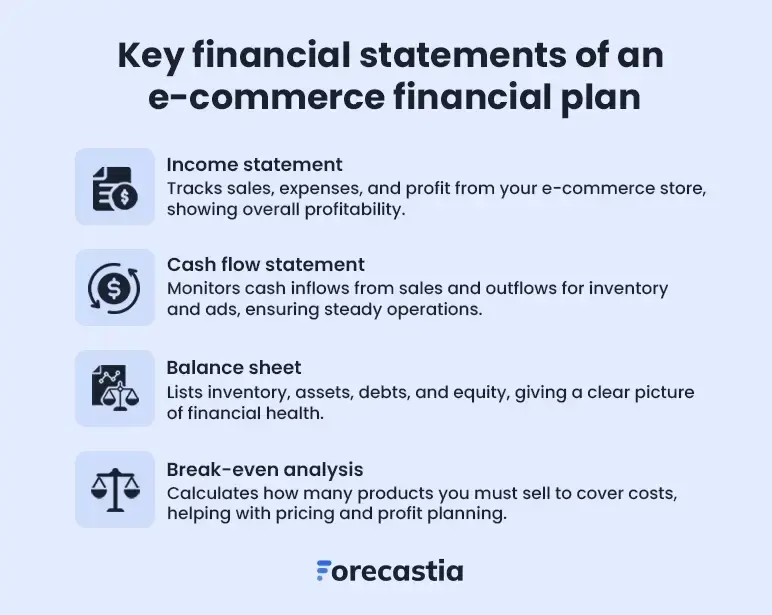Running an e-commerce business isn’t just about selling great products; it’s about making sure your store stays profitable.
Without a good financial plan, expenses can pile up, cash flow can dry, and surprise expenses can cause serious issues.
That's why you need an e-commerce financial plan. It enables you to monitor spending, determine proper prices, and maintain stable profits.
But how do you make one?
This article will break it into easy, actionable steps to enable you to create a solid, profitable e-commerce business. Let's begin!
How do you build e-commerce business financial projections?
Creating realistic financial projections for your e-commerce business involves thorough analysis and meticulous planning to comprehend its financial health and growth potential.
Here’s a step-by-step guide to help you build accurate and actionable projections while ensuring you factor in every detail:

1. Gather essential information
First, collect all the relevant key data that lays the groundwork for accurate financial projections.
This would include your e-commerce store details like:
- Current operations
- Target demographics
- Historical financial performance
- And industry benchmarks.
Start with your sales data—analyze daily and weekly revenue trends, peak shopping periods, and how sales fluctuate with seasons, holidays, and promotions.
For a new e-commerce business, analyze the latest market trends, industry benchmarks, and local competitors to make educated estimates.
Further, understand your customers inside out.
- Who are they?
- What do they buy the most?
- What influences their shopping decisions?
Then, track inventory data—monitor stock levels, turnover rates, and supplier costs to keep pricing and expenses under control.
Most importantly, don’t forget to evaluate the past performance data of your e-commerce company to understand what drives your business.
Consider analyzing previous revenues, costs, and profits to detect trends and highlight the areas for improvement. Check how your marketing campaigns, product listings, or seasonal sales impacted your revenue, customer demand, and overall costs.
That’s how you'll have everything you need to create accurate and actionable financial projections.
2. Make rough pre-assumptions
Now, make some preliminary assumptions for your e-commerce financial projections based on gathered data. Such estimates will outline your business's revenues, expenses, and profitability levels.
Start by focusing on the basics: How much you’ll make in monthly sales, how much customers will spend on average, and what your operating costs might look like.
Use the understanding of past sales trends, industry benchmarks, and your own research. Also, consider factors like seasonal trends, upcoming product launches, or holiday sales that could impact your revenue and costs.
Here are a few key metrics to consider while making your assumptions:
- Revenue growth: Forecast a percentage sales increase, for example, 5% annual growth based on an increasing customer base or promotion.
- Cost hikes: Anticipate possible increases in supplier costs, shipping charges, or platform fees, like a 10% ad spend increase during peak shopping periods.
- Seasonality: Adjust for holiday sales peaks, back-to-school seasons, or slow months such as post-holiday January.
- Economic conditions: Factor in inflation, increasing wages, or other economic conditions that could affect both expenses and customer purchasing power.
Don’t aim for perfection—these are rough estimates to guide your planning that will evolve over time. So, revisit them periodically as actual data comes in.
3. Make revenue projections
Revenue projections are all about figuring out how much money your e-commerce business might make.
To get started, think about a few simple things: How many visitors you get, how often they buy, and the average order value.
Breaking it down step-by-step makes it easier to see your earning potential.
If your e-commerce store gets 500 visitors a day, and your average order value is $50, here’s what that looks like in sales:
500 orders × $50 × 30 days
= $750,000/month
You also have to think about things like holidays, sales events, and weekends, these usually bring in more customers and boost sales. But there will also be slow months or mid-week dips when sales aren’t as high.
On top of regular sales, you can make extra money by upselling premium products, offering subscriptions, using affiliate marketing, or charging for express shipping. These extra income streams can make a big difference in your total earnings.
When you factor in all these sources of income, you get a much clearer idea of how much your e-commerce company can actually make.
Revenue projections aren’t just about numbers, they help you set realistic expectations and prepare for both busy and slow times.
4. Calculate the Cost of Goods Sold (COGS)
The next step is to calculate your Cost of Goods Sold (COGS)—essentially, the direct costs of selling your products. This includes inventory, packaging, payment processing fees, and shipping costs.
Here's an easy way to do your COGS calculation:

For example: If you’re spending $30,000 on inventory and shipping to make $100,000. It means you’re spending 30% of your earnings on direct costs. The lower your COGS, the higher your profit margin.
Knowing your COGS will help you manage expenses, optimize resources, and boost profits.
5. Estimate operating costs
Then, detail the anticipated cost incurred to run your online e-commerce business.
When determining operational expenditures, begin with the fixed charges that remain constant every month, such as website hosting, software licenses, warehouse leases, and employees' salaries.
Then, determine variable costs that fluctuate with time, including shipping charges, payment processing fees, advertising expenses, and packaging materials.
Finally, add up the fixed and variable costs to arrive at your total operating costs.
Example:
Website hosting: $2,000
Shipping costs: $5,000
Salaries: $30,000
Marketing expenses: $8,000
By adding all the above expenses, the monthly expense will be:
$2,000 + $5,000 + $30,000 + $8,000
= $45,000.
Overall, by calculating your operating costs, you can manage your budget and know whether your revenues can cover all the expenses to leave room for profit.
6. Prepare financial statements
After estimating your e-commerce business revenue, COGS, and operating expenses, it’s time to draft clear financial statements. These documents are essential for illustrating your e-commerce store’s financial health and growth potential to prospective investors.
These are the key financial reports and statements you need to include in your plan:
- Income statement
- Cash flow statement
- Balance sheet
- Break-even analysis
By including these financial reports, you present your financial position to prospective investors so that they can make informed investment decisions.
We will examine each of these financial elements in more detail in the sections that follow, providing you with the insights necessary to develop a solid financial plan.
7. Prepare visual reports
Numbers alone aren't enough. Give your e-commerce business’s financial information in a visually pleasing and easily consumable form that readers can readily grasp and derive valuable insights from.
Charts and graphs help make it simpler to identify your e-commerce company's major features, such as revenue patterns, costs, profit margins, and cash flow.
Use straightforward bar charts, pie charts, and line graphs to make the data clear. Also, highlight patterns like seasonal sales changes or rising costs to help with planning.
This will not only help analyze financial data but also enable you to communicate key metrics effectively to your team as well as investors.
8. Test assumptions, consider scenario analysis
Finally, take a step back and test the numbers to ensure your projections are more accurate. Try to run different scenarios (best- and worst-case) to see how changes impact your financial outcomes.
For instance, analyze what happens if supplier costs rise by 15% or sales decline during off-peak seasons like post-holiday months.
Considering these “what-if” situations helps you identify potential problems in business operations and come up with solutions in advance. It even increases transparency and lets investors better understand your e-commerce company’s future with different scenarios.
Overall, these test assumptions and sensitivity analyses will help you make strategic decisions and necessary adjustments to keep your e-commerce business running smoothly.
Key financial statements of an e-commerce financial plan
A comprehensive e-commerce financial plan would contain key financial documents such as the income statement, statement of cash flows, balance sheet, and break-even analysis.
These statements clearly define your online business firm's current financial situation and the overall financial plan to realize future objectives.

Let's explore each statement in detail.
1) Income statement
The profit and loss statement or income statement is also referred to as a P&L. It provides you with a clear view of your e-commerce business's net profit, gross margin, revenue, and expenses over a given period.
It assists you in viewing whether your company is generating sufficient revenue to pay for its expenses and make a profit.
The gross profit is what you have after you deduct the COGS from the overall revenue. This shows how efficiently your e-commerce store uses its resources.
Further, divide the gross profit by revenue and convert it into a percentage to determine the gross margin.
Then, reduce operating costs like rent, salary, and utility to get the EBITDA. Finally, subtract interest, taxes, depreciation, and amortization from the EBITDA to arrive at the net profit of your e-commerce venture—the figure that investors care about the most.
Here’s an example of a small e-commerce store’s income statement to demonstrate these calculations:
| Category | Amount ($) |
|---|---|
| Revenue | |
| Online Sales Revenue | $3,500,000 |
| Subscription Revenue | $500,000 |
| Other Revenue (Affiliates, Ads) | $150,000 |
| Total Revenue | $4,150,000 |
| Cost of Goods Sold (COGS) | |
| Product Sourcing & Manufacturing | $1,500,000 |
| Shipping & Fulfillment | $400,000 |
| Payment Processing Fees | $100,000 |
| Returns & Refunds | $80,000 |
| Total COGS | $2,080,000 |
| Gross Profit | $2,070,000 |
| Operating Expenses | |
| Sales & Marketing | $700,000 |
| Website & Tech Infrastructure | $250,000 |
| Customer Support | $150,000 |
| Warehousing & Storage | $180,000 |
| General & Admin (G&A) | $200,000 |
| Total Operating Expenses | $1,480,000 |
| Operating Profit (EBIT) | $590,000 |
| Other Income & Expenses | |
| Interest Income | $20,000 |
| Loan Interest Expense | ($40,000) |
| Taxes (20%) | ($110,000) |
| Net Profit | $460,000 |
The company gets $4,150,000 in revenue. COGS (Cost of Goods Sold) is $2,080,000—this includes product costs, shipping, payment processing, and returns. That leaves us with a gross profit of $2,070,000—a solid starting point.
Now, let’s look at operating expenses. The business spends:
- $7,00,000 on marketing (gotta get those customers in),
- $2,50,000 on tech & infrastructure (because websites and apps don’t run themselves),
- $1,50,000 on customer support,
- $1,80,000 on warehousing (storing all that inventory).
All of this adds up to $1,480,000 in total expenses, bringing the operating profit (EBIT) to $590,000.
Then, we factor in:
- $20,000 in interest income (probably from investments or savings),
- $40,000 in loan interest (debt costs money),
- $1,10,000 in taxes (because, well… taxes).
After all that, the company nets $460,000 in profit.
Bottom line? This business is running efficiently, keeping strong margins, and has plenty of room to grow.
In simple terms, the income statement tells you if your e-commerce company is making enough money and staying financially healthy over time.
2) Cash flow statement
A cash flow statement shows how money is coming in and going out of your online store over a certain period. It helps you figure out if you have enough cash to cover your daily expenses.
It’s also great for spotting potential cash shortages, especially during slower months, and demonstrates how much cash is coming from operations compared to things like investments or loans.
To create one, you’ll need to include cash from sales, costs like inventory and shipping, and other overhead expenses like marketing and platform fees. It highlights how much money your e-commerce company is making and spending during that period.
| Category | Amount (USD) |
|---|---|
| Operating Cash Flow | |
| Sales Revenue | $20,000 |
| Returns & Refunds | ($1,000) |
| Cost of Goods Sold (COGS) | ($10,000) |
| Marketing & Advertising | ($3,000) |
| Website Maintenance & Hosting | ($500) |
| Payment Processing Fees | ($600) |
| Net Operating Cash Flow | $4,900 |
| Investing Cash Flow | |
| Purchase of Equipment | ($2,000) |
| Software Development Costs | $0 |
| Net Investing Cash Flow | ($2,000) |
| Financing Cash Flow | |
| Loan Received | $10,000 |
| Loan Repayment | ($1,000) |
| Owner’s Investment | $5,000 |
| Net Financing Cash Flow | $14,000 |
| Net Cash Flow (Total) | $16,900 |
| Opening Cash Balance | $5,000 |
| Closing Cash Balance | $21,900 |
That said, it’s a good illustration of how well your business is at generating cash. The precision of your projections in these aspects directly impacts the reliability of your cash flow.
So, be realistic with the assumptions you make in the cash flow statement. Use industry standards and consider market situations to ensure accuracy.
3) Balance sheet
A balance sheet gives a quick snapshot of your e-commerce company’s financial position for a specific timeframe. It shows what the e-commerce business owns, what it owes to others, and what’s left for you.
After all, it covers these key elements:
- Assets: Cash on hand, accounts receivable, inventory, and warehouse or equipment.
- Liabilities: Financial obligations like short-term debts and long-term loans.
- Equity: The leftover earnings once liabilities are subtracted from assets.
Ideally, it’s presented as, Assets = Liabilities + Equity.
E-commerce Business Balance Sheet Example
Let’s say you run an online fashion store. Here’s what your balance sheet might look like:
Assets (What Your Business Owns 💰)
- Cash in Bank: $500,000 (From sales and profits)
- Accounts Receivable: $75,000 (Pending customer payments)
- Inventory: $250,000 (Clothing stock)
- Website & Equipment: $100,000 (E-commerce business platform, tools)
- Total Assets: $925,000
Liabilities (What Your Business Owes 💸)
- Accounts Payable: $60,000 (Supplier invoices)
- Short-Term Loan: $80,000 (For new inventory)
- Total Liabilities: $140,000
Equity (What’s Left ✅)
- Owner Investment: $300,000
- Retained Earnings: $485,000 (Profits reinvested)
- Total Equity: $785,000
📊 Total Liabilities & Equity: $925,000
Investors pay close attention to the balance sheet because it shows them your e-commerce business’s financial structure, return on investment (ROI), and overall stability.
It also provides an idea of the cash that’s available to you, how the money is blocked, and what kind of solid business you’re running.
4) Break-even analysis
We all know that profit is the all-time motive of all e-commerce business owners. The real question is: When does the money actually start coming in?
A break-even analysis fits the bill at this stage. It shows exactly how much you’ll need to generate in revenue for all the costs to be recovered—no profit and no loss; just breaking even.
Let's take an example to see how it works.
For an e-commerce store:
- Fixed costs: $12,000 (including website hosting: $2,000, storage fees: $5,000, salaries: $5,000)
- Variable costs: $30,000 (inventory, packaging, shipping, transaction fees)
- Revenue: $90,000
- Contribution Margin: ($90,000 - $30,000) ÷ $90,000 = 0.6667 (or 66.67%)
- Break-even sales calculation: $12,000 ÷ 0.6667 = $18,001
So, this e-commerce store needs to generate at least $18,001 per month to break even.
This analysis shows exactly how much revenue is needed to reach the point where your total sales just cover your costs, causing no profit or loss.
In addition, this will give potential investors or lenders a fair idea of when your e-commerce business would be profitable.
Download free e-commerce financial projections example
Creating an e-commerce financial plan from scratch seems overwhelming. After all, Excel sheets are tiring and endlessly long. But no worries! We’re here to help you with our free e-commerce financial plan sample.
It covers all the key components of an e-commerce business's financial projection, such as sales forecast, P&L or income statement, balance sheet, cash flows, and break-even analysis, simplifying the entire financial planning process to help you get started.
Build accurate financial projections using Forecastia
That’s it! We’ve discussed almost everything about creating an e-commerce company’s financial projections in this guide. Now, it should be much easier for you to put that knowledge into action and start planning.
But if it still feels like a lot to handle, don’t worry; Forecastia is the only AI-powered financial forecasting tool you need to make the process simple and stress-free.
It’s specifically designed for businesses looking to build accurate financial projections, anticipate future cash flows, and analyze overall financial performance—all without using spreadsheets!
Frequently Asked Questions
What are the key financial statements in an e-commerce financial plan?
The key financial statements include:
- Income statement (Profit & Loss) – Shows revenue, expenses, and net profit.
- Cash flow statement – Tracks money coming in and going out.
- Balance sheet – Lists assets, liabilities, and equity.
- Break-even analysis – Determines how much revenue is needed to cover costs.
What are common operating expenses in an e-commerce financial plan?
Common expenses include:
- Fixed costs: Website hosting, platform fees, salaries, and storage.
- Variable costs: Inventory, shipping, transaction fees, and marketing.
How do I create financial projections for my e-commerce business?
While creating financial projections for your e-commerce business, follow these steps:
- Estimate sales, average order value, and expenses.
- Use past trends, market research, and growth forecasts.
- Plan for 1-5 years based on expected performance.
How often should I update my e-commerce company’s financial projections?
Review and adjust financial projections quarterly or when there are major changes in sales trends, supplier costs, or business strategy.
How to use the e-commerce business financial projections template?
A template simplifies financial planning. Here’s what to do:
- Enter sales, costs, and growth rates.
- The template calculates revenue, profit margins, and break-even points.
- Use it to make data-driven financial decisions.

